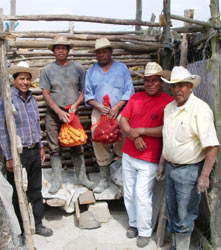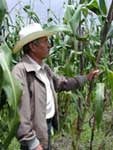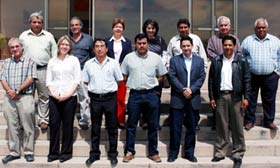CIMMYT E-News, vol 5 no. 2, February 2008
 The State of Mexico borders the country’s capital, Mexico City—a potential market of nearly 20 million inhabitants—but farmers there have struggled to make a profit growing maize. CIMMYT is working to help them, as part of a new partnership between the US Department of Agriculture (USDA) and the Mexican Agriculture Secretariat (SAGARPA).
The State of Mexico borders the country’s capital, Mexico City—a potential market of nearly 20 million inhabitants—but farmers there have struggled to make a profit growing maize. CIMMYT is working to help them, as part of a new partnership between the US Department of Agriculture (USDA) and the Mexican Agriculture Secretariat (SAGARPA).
A mountainous entity in the geographical and cultural center of Mexico, the State of Mexico occupies what many would consider an envious position: it surrounds the country’s vibrant and populous capital, Mexico City, whose 18 million-plus population represents an attractive market for goods and services. Industries dominate the state economy, but many inhabitants outside urban areas practice farming, either to supplement their incomes or, in fewer cases, as their chief livelihood. Most of the state’s farmers have grown maize at one time or another, but few have made a profit on the crop, despite their proximity to a megalopolis.
 Years of low prices, until recently, for maize grain have discouraged farmers from investing in advanced practices or new varieties. “The state of Mexico accounts for ten percent of national maize production, but improved varieties occupy little more than a tenth of its maize area,” says CIMMYT maize researcher Silverio García. “And nearly all the maize they produce is white grained and ideal for local foods, but fails to meet market standards for large-scale, commercial tortilla production, feed or industrial uses.”
Years of low prices, until recently, for maize grain have discouraged farmers from investing in advanced practices or new varieties. “The state of Mexico accounts for ten percent of national maize production, but improved varieties occupy little more than a tenth of its maize area,” says CIMMYT maize researcher Silverio García. “And nearly all the maize they produce is white grained and ideal for local foods, but fails to meet market standards for large-scale, commercial tortilla production, feed or industrial uses.”
The state of maize
As part of a project launched in 2007 between the USDA and SAGARPA, CIMMYT is working with counterparts in the State of Mexico to increase the productivity and profitability of maize farming. Aims include a broad characterization of maize varieties—both local and improved—for traits of market value; breeding for market requirements; farmer-participatory improvement and testing of varieties; and food technology and nutrition research to guide the project and demonstrate potential impact.
“The focus is on value-added blue, white, and purple maize for food,” says CIMMYT maize breeder and project leader, Gary Atlin. “But partly in response to declining supplies and rising world prices of maize—driven at least in part by the biofuels boom in the USA—farmers are increasingly interested in yellow maize, and participants are developing and testing yellow grain maize suited for feed and industrial markets.”
 Atlin and Garcia recently led a workshop of 11 maize scientists from the Mexican National Institute of Forestry, Agriculture, and Livestock Research (INIFAP), Mexico State’s Institute of Agriculture, Livestock, Water, and Forestry Research and Training (ICAMEX), the Colegio de Postgraduados (a graduate-level agricultural research and learning institution), and CIMMYT to plan project activities. Participants contributed detailed information on varieties grown in the state, agreed on common software for managing and analyzing data from trials, and discussed ways to foster farmer participation.
Atlin and Garcia recently led a workshop of 11 maize scientists from the Mexican National Institute of Forestry, Agriculture, and Livestock Research (INIFAP), Mexico State’s Institute of Agriculture, Livestock, Water, and Forestry Research and Training (ICAMEX), the Colegio de Postgraduados (a graduate-level agricultural research and learning institution), and CIMMYT to plan project activities. Participants contributed detailed information on varieties grown in the state, agreed on common software for managing and analyzing data from trials, and discussed ways to foster farmer participation.
Efforts are building on prior work by CIMMYT in Mexico to promote adoption of improved varieties in poorer regions, through crossing local varieties and improved populations to improve farmer-identified traits lacking in their varieties. CIMMYT has also worked with Mexican breeders to develop improved, yellow-grain varieties for several environments, including the Mexican highlands.
“We’re very excited about this project,” says García. “Trials in 2008 will involve experimental varieties that are crosses between improved and local materials, pre-commercial varieties in 20 or more environments in the state, and 40 on-farm demonstrations of commercially-available white and yellow hybrids to get farmers’ feedback.”
For information: Silverio García Lara, maize breeder (s.garcia@cgiar.org)

